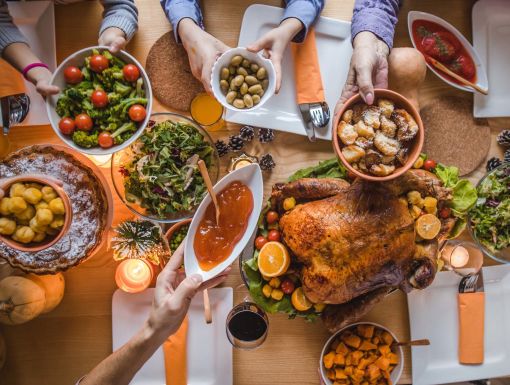
Mindful Eating: 5 Tips for Staying on Track During the Holidays
The holidays are a wonderful time, but they also present unique challenges when it comes to nutrition. So many of our cherished traditions are centered around food. Holiday gatherings lead to greater availability of calorie-dense foods that are high in fat and/or sugar, as well as alcohol. It becomes easy to find ourselves in an all-or-nothing mindset, feeling that we need to forgo these foods altogether, or if we do indulge thinking that the day is a “wash” when it comes to meeting our health goals.
Breaking out of this mindset is key to both enjoying the traditional holiday foods we look forward to, while fueling our bodies well with good nutrition.
How to practice mindful eating during the holidays
Employ these principles of mindful eating to foster a healthy relationship with food during the holiday season:
- Ditch the black-and-white mindset. Eating something that you consider unhealthy does not have to sabotage your whole day, week, month, or holiday season! There is a place for occasional treats in the scope of an overall healthy diet.
- Savor your food. As much as possible, sit down, eat slowly and put away the screens during meal times.
- Pay attention to color, smell, texture, and taste. Be intentional to appreciate the food you’re eating.
- Leave behind the “happy plate” concept from childhood. Contrary to the popular phrase said to children to “make a happy plate,” the idea that we need to empty our plates can lead to overeating and overrides the ability to self-regulate when feeling full. Eating slowly can help to pay attention to feelings of fullness.
- Let go of the guilt. Give yourself permission to enjoy, knowing that there is a time and place for all kinds of foods!
Focus on what you’re adding to your diet, not subtracting. Set small, manageable goals to keep your health a priority through the holiday season. For example, if you want to work on being better hydrated, but are currently drinking only one small bottle of water a day, start with aiming for two and build from there. Some examples of health-promoting behaviors are:
- Aim for four to five servings of fruits and vegetables each day.
- Use the “plate method” to fill your plate for each meal. Make half of your plate non-starchy vegetables, one fourth plate a lean protein, and the remaining one fourth a complex carbohydrate such as lentils, quinoa, whole grain bread, beans or sweet potato.
- Incorporate protein or heart-healthy fats with each meal and snack to keep you feeling full and satiated.
- Incorporate all the colors. Each color of your food provides a different micronutrient profile. Vibrant colors such as dark green, orange/yellow, red and purple make both a beautiful plate and provide a variety of phytochemicals with various health benefits.
- Drink a glass of water before every meal. For most people, aim for half of your body weight in ounces of fluid daily, with an additional 16-24 ounces for each pound of sweat lost in exercise. (Example: A 200-pound person should aim for 100 ounces of fluid.)
- Make time for rest. Give yourself the gift of rest this holiday season. Good quality sleep is essential for meeting your health and nutrition goals!
- Eat a balanced, filling meal before the Christmas feast or holiday party so you don’t arrive famished. Waiting all day to eat before a feast can decrease our actual enjoyment of the meal because we tend to eat too quickly, sometimes leading to ignoring feelings of fullness.
Overall, give yourself grace. Take time to slow down and savor the special food you are enjoying and the memories that come with it.
Learn more about Ochsner Eat Fit.


